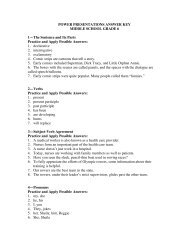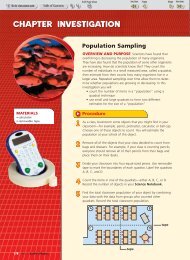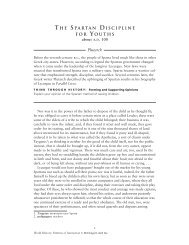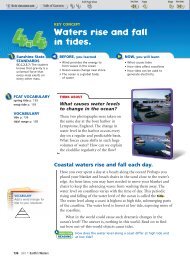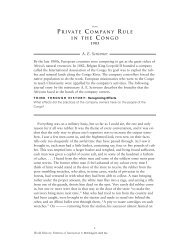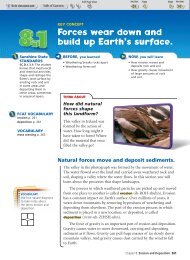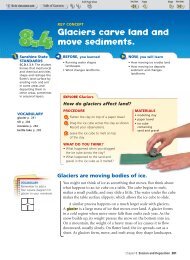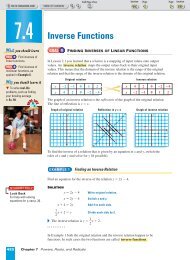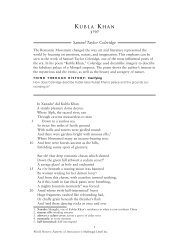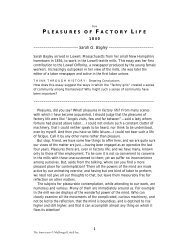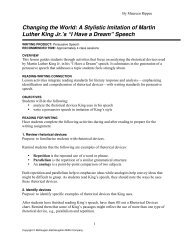Earth rotates on a tilted axis and orbits the Sun. - ClassZone
Earth rotates on a tilted axis and orbits the Sun. - ClassZone
Earth rotates on a tilted axis and orbits the Sun. - ClassZone
Create successful ePaper yourself
Turn your PDF publications into a flip-book with our unique Google optimized e-Paper software.
<strong>Sun</strong>shine State<br />
STANDARDS<br />
SC.E.1.3.1: The student<br />
underst<strong>and</strong>s <strong>the</strong> vast<br />
size of our Solar<br />
System <strong>and</strong> <strong>the</strong> relati<strong>on</strong>ship<br />
of <strong>the</strong> planets<br />
<strong>and</strong> <strong>the</strong>ir satellites.<br />
SC.H.1.3.5: The student<br />
knows that a change in<br />
<strong>on</strong>e or more variables<br />
may alter <strong>the</strong> outcome<br />
of an investigati<strong>on</strong>.<br />
SC.H.2.3.1: The student<br />
recognizes that patterns<br />
exist within <strong>and</strong><br />
across systems.<br />
VOCABULARY<br />
<strong>axis</strong> of rotati<strong>on</strong> p. 708<br />
revoluti<strong>on</strong> p. 709<br />
seas<strong>on</strong> p. 710<br />
equinox p. 710<br />
solstice p. 710<br />
KEY CONCEPT<br />
<str<strong>on</strong>g>Earth</str<strong>on</strong>g> <str<strong>on</strong>g>rotates</str<strong>on</strong>g> <strong>on</strong> a <strong>tilted</strong><br />
<strong>axis</strong> <strong>and</strong> <strong>orbits</strong> <strong>the</strong> <strong>Sun</strong>.<br />
BEFORE, you learned<br />
• Stars seem to rise, cross <strong>the</strong> sky,<br />
<strong>and</strong> set because <str<strong>on</strong>g>Earth</str<strong>on</strong>g> turns<br />
• The <strong>Sun</strong> is very large <strong>and</strong> far<br />
from <str<strong>on</strong>g>Earth</str<strong>on</strong>g><br />
• <str<strong>on</strong>g>Earth</str<strong>on</strong>g> <strong>orbits</strong> <strong>the</strong> <strong>Sun</strong><br />
EXPLORE Time Z<strong>on</strong>es<br />
NOW, you will learn<br />
• Why <str<strong>on</strong>g>Earth</str<strong>on</strong>g> has day <strong>and</strong> night<br />
• How <strong>the</strong> changing angles of<br />
sunlight produce seas<strong>on</strong>s<br />
What time is it in Icel<strong>and</strong> right now?<br />
PROCEDURE<br />
1<br />
2<br />
Find your locati<strong>on</strong> <strong>and</strong> Icel<strong>and</strong> <strong>on</strong> <strong>the</strong> map.<br />
Identify <strong>the</strong> time z<strong>on</strong>e of each.<br />
Count <strong>the</strong> number of hours between your<br />
locati<strong>on</strong> <strong>and</strong> Icel<strong>and</strong>. Add or subtract that<br />
number of hours from <strong>the</strong> time <strong>on</strong> your clock.<br />
WHAT DO YOU THINK?<br />
• By how much is Icel<strong>and</strong>’s time earlier or later<br />
than yours?<br />
•Why are clocks set to different times?<br />
MATERIAL<br />
time z<strong>on</strong>e map<br />
<str<strong>on</strong>g>Earth</str<strong>on</strong>g>’s rotati<strong>on</strong> causes day <strong>and</strong> night.<br />
When astr<strong>on</strong>auts explored <strong>the</strong> Mo<strong>on</strong>, <strong>the</strong>y felt <strong>the</strong> Mo<strong>on</strong>’s gravity<br />
pulling <strong>the</strong>m down. Their usual “down”—<str<strong>on</strong>g>Earth</str<strong>on</strong>g>—was up in <strong>the</strong><br />
Mo<strong>on</strong>’s sky.<br />
As you read this book, it is easy to tell which way is down. But is<br />
down in <strong>the</strong> same directi<strong>on</strong> for a pers<strong>on</strong> <strong>on</strong> <strong>the</strong> o<strong>the</strong>r side of <str<strong>on</strong>g>Earth</str<strong>on</strong>g>?<br />
If you both pointed down, you would be pointing toward each o<strong>the</strong>r.<br />
<str<strong>on</strong>g>Earth</str<strong>on</strong>g>’s gravity pulls objects toward <strong>the</strong> center of <str<strong>on</strong>g>Earth</str<strong>on</strong>g>. No matter where<br />
you st<strong>and</strong> <strong>on</strong> <str<strong>on</strong>g>Earth</str<strong>on</strong>g>, <strong>the</strong> directi<strong>on</strong> of down will be toward <str<strong>on</strong>g>Earth</str<strong>on</strong>g>’s center.<br />
There is no bottom or top. Up is out toward space, <strong>and</strong> down is toward<br />
<strong>the</strong> center of <strong>the</strong> planet.<br />
As <str<strong>on</strong>g>Earth</str<strong>on</strong>g> turns, so do you. You keep <strong>the</strong> same positi<strong>on</strong> with respect<br />
to what is below your feet, but <strong>the</strong> view above your head changes.<br />
check your reading In what directi<strong>on</strong> does gravity pull objects near <str<strong>on</strong>g>Earth</str<strong>on</strong>g>?<br />
Chapter 20: <str<strong>on</strong>g>Earth</str<strong>on</strong>g>, Mo<strong>on</strong>, <strong>and</strong> <strong>Sun</strong> 707
The globe <strong>and</strong> <strong>the</strong> flat<br />
map show <strong>the</strong> progress<br />
of daylight across <str<strong>on</strong>g>Earth</str<strong>on</strong>g><br />
in two ways. This locati<strong>on</strong><br />
is experiencing sunrise.<br />
What causes day <strong>and</strong> night?<br />
708 Unit 6: Space Science<br />
The directi<strong>on</strong>s north, south, east, <strong>and</strong> west are based <strong>on</strong> <strong>the</strong> way <strong>the</strong><br />
planet <str<strong>on</strong>g>rotates</str<strong>on</strong>g>, or turns. <str<strong>on</strong>g>Earth</str<strong>on</strong>g> <str<strong>on</strong>g>rotates</str<strong>on</strong>g> around an imaginary line running<br />
through its center called an <strong>axis</strong> of rotati<strong>on</strong>. The ends of <strong>the</strong> <strong>axis</strong> are<br />
<strong>the</strong> north <strong>and</strong> south poles. Any locati<strong>on</strong> <strong>on</strong> <strong>the</strong> surface moves from west<br />
to east as <str<strong>on</strong>g>Earth</str<strong>on</strong>g> turns. If you<br />
extend your right thumb <strong>and</strong><br />
pretend its tip is <strong>the</strong> North Pole,<br />
<strong>the</strong>n your fingers curve <strong>the</strong> way<br />
<str<strong>on</strong>g>Earth</str<strong>on</strong>g> <str<strong>on</strong>g>rotates</str<strong>on</strong>g>.<br />
At any <strong>on</strong>e time, about half<br />
of <str<strong>on</strong>g>Earth</str<strong>on</strong>g> is in sunlight <strong>and</strong> half<br />
is dark. However, <str<strong>on</strong>g>Earth</str<strong>on</strong>g> turns <strong>on</strong><br />
its <strong>axis</strong> in 24 hours, so locati<strong>on</strong>s<br />
move through <strong>the</strong> light <strong>and</strong><br />
darkness in that time. When a<br />
locati<strong>on</strong> is in sunlight, it is day-<br />
time <strong>the</strong>re. When a locati<strong>on</strong> is in <strong>the</strong> middle of <strong>the</strong> sunlit side, it is<br />
no<strong>on</strong>. When a locati<strong>on</strong> is in darkness, it is night <strong>the</strong>re, <strong>and</strong> when <strong>the</strong><br />
locati<strong>on</strong> is in <strong>the</strong> middle of <strong>the</strong> unlit side, it is midnight.<br />
check your reading If it is no<strong>on</strong> at <strong>on</strong>e locati<strong>on</strong>, what time is it at a locati<strong>on</strong> directly<br />
<strong>on</strong> <strong>the</strong> o<strong>the</strong>r side of <str<strong>on</strong>g>Earth</str<strong>on</strong>g>?<br />
In this model <strong>the</strong> lamp represents <strong>the</strong> <strong>Sun</strong>, <strong>and</strong> your head represents <str<strong>on</strong>g>Earth</str<strong>on</strong>g>.<br />
The North Pole is at <strong>the</strong> top of your head. You will need to imagine locati<strong>on</strong>s<br />
<strong>on</strong> your head as if your head were a globe.<br />
PROCEDURE<br />
1<br />
2<br />
3<br />
4<br />
no<strong>on</strong><br />
night moves<br />
westward<br />
Rotati<strong>on</strong><br />
Face <strong>the</strong> lamp <strong>and</strong> hold your h<strong>and</strong>s to your face as shown in <strong>the</strong> photograph.<br />
Your h<strong>and</strong>s mark <strong>the</strong> horiz<strong>on</strong>. For a pers<strong>on</strong> located at your nose, <strong>the</strong> <strong>Sun</strong><br />
would be high in <strong>the</strong> sky. It would be no<strong>on</strong>.<br />
Face away from <strong>the</strong> lamp. Determine what time it would be at your nose.<br />
Turn to your left until you see <strong>the</strong> lamp al<strong>on</strong>g your left h<strong>and</strong>.<br />
C<strong>on</strong>tinue turning to <strong>the</strong> left, through no<strong>on</strong>, until you just stop seeing <strong>the</strong> lamp.<br />
WHAT DO YOU THINK?<br />
• What times was it at your nose in steps 2, 3, <strong>and</strong> 4?<br />
•When you face <strong>the</strong> lamp, what time is it at your right ear?<br />
CHALLENGE How can a cloud be bright even when it is dark <strong>on</strong> <strong>the</strong> ground?<br />
midnight<br />
SKILL FOCUS<br />
Making models<br />
MATERIALS<br />
lamp<br />
TIME<br />
15 minutes
<str<strong>on</strong>g>Earth</str<strong>on</strong>g>’s <strong>tilted</strong> <strong>axis</strong> <strong>and</strong> orbit cause seas<strong>on</strong>s.<br />
Just as gravity causes objects near <str<strong>on</strong>g>Earth</str<strong>on</strong>g> to be pulled toward <str<strong>on</strong>g>Earth</str<strong>on</strong>g>’s<br />
center, it also causes <str<strong>on</strong>g>Earth</str<strong>on</strong>g> <strong>and</strong> o<strong>the</strong>r objects near <strong>the</strong> <strong>Sun</strong> to be pulled<br />
toward <strong>the</strong> <strong>Sun</strong>’s center. Fortunately, <str<strong>on</strong>g>Earth</str<strong>on</strong>g> does not move straight<br />
into <strong>the</strong> <strong>Sun</strong>. <str<strong>on</strong>g>Earth</str<strong>on</strong>g> moves sideways, at nearly a right angle to <strong>the</strong><br />
<strong>Sun</strong>’s directi<strong>on</strong>. Without <strong>the</strong> <strong>Sun</strong>’s gravitati<strong>on</strong>al pull, <str<strong>on</strong>g>Earth</str<strong>on</strong>g> would<br />
keep moving in a straight line out into deep space. However, <strong>the</strong><br />
<strong>Sun</strong>’s pull changes <str<strong>on</strong>g>Earth</str<strong>on</strong>g>’s path from a straight line to a round orbit<br />
about 300 milli<strong>on</strong> kilometers (200,000,000 mi) across.<br />
Just as a day is <strong>the</strong> time it takes <str<strong>on</strong>g>Earth</str<strong>on</strong>g> to rotate <strong>on</strong>ce <strong>on</strong> its <strong>axis</strong>,<br />
a year is <strong>the</strong> time it takes <str<strong>on</strong>g>Earth</str<strong>on</strong>g> to orbit <strong>the</strong> <strong>Sun</strong> <strong>on</strong>ce. In astr<strong>on</strong>omy,<br />
a revoluti<strong>on</strong> is <strong>the</strong> moti<strong>on</strong> of <strong>on</strong>e object around ano<strong>the</strong>r. The word<br />
revoluti<strong>on</strong> can also mean <strong>the</strong> time it takes an object to go around <strong>on</strong>ce.<br />
<str<strong>on</strong>g>Earth</str<strong>on</strong>g>’s rotati<strong>on</strong> <strong>and</strong> orbit do not quite line up. If <strong>the</strong>y did, <str<strong>on</strong>g>Earth</str<strong>on</strong>g>’s<br />
equator would be in <strong>the</strong> same plane as <str<strong>on</strong>g>Earth</str<strong>on</strong>g>’s orbit, like a tiny hoop<br />
<strong>and</strong> a huge hoop lying <strong>on</strong> <strong>the</strong> same tabletop. Instead, <str<strong>on</strong>g>Earth</str<strong>on</strong>g> <str<strong>on</strong>g>rotates</str<strong>on</strong>g> at<br />
about a 23˚ angle, or tilt, from this lined-up positi<strong>on</strong>.<br />
orbit<br />
23°<br />
23°<br />
<str<strong>on</strong>g>Earth</str<strong>on</strong>g>’s <strong>axis</strong> points in a c<strong>on</strong>stant directi<strong>on</strong><br />
as <str<strong>on</strong>g>Earth</str<strong>on</strong>g> <strong>orbits</strong> <strong>the</strong> <strong>Sun</strong>. <str<strong>on</strong>g>Earth</str<strong>on</strong>g> is <strong>tilted</strong><br />
23˚ from its orbit.<br />
Use your thumb to represent <strong>the</strong> North Pole.<br />
Keep it steady as you move your h<strong>and</strong> in a<br />
counterclockwise circle <strong>on</strong> a tabletop.<br />
Not to scale<br />
As <str<strong>on</strong>g>Earth</str<strong>on</strong>g> moves, its <strong>axis</strong> always points in <strong>the</strong> same directi<strong>on</strong> in space.<br />
You could model <str<strong>on</strong>g>Earth</str<strong>on</strong>g>’s orbit by moving your right fist in a circle <strong>on</strong><br />
a desktop. You would need to point your thumb toward your left<br />
shoulder <strong>and</strong> keep it pointing that way while moving your h<strong>and</strong><br />
around <strong>the</strong> desktop.<br />
<str<strong>on</strong>g>Earth</str<strong>on</strong>g>’s orbit is not quite a perfect circle. In January, <str<strong>on</strong>g>Earth</str<strong>on</strong>g> is about<br />
5 milli<strong>on</strong> kilometers closer to <strong>the</strong> <strong>Sun</strong> than it is in July. You may be<br />
surprised to learn that this distance makes <strong>on</strong>ly a tiny difference in<br />
temperatures <strong>on</strong> <str<strong>on</strong>g>Earth</str<strong>on</strong>g>. However, <strong>the</strong> combinati<strong>on</strong> of <str<strong>on</strong>g>Earth</str<strong>on</strong>g>’s moti<strong>on</strong><br />
around <strong>the</strong> <strong>Sun</strong> with <strong>the</strong> tilt of <str<strong>on</strong>g>Earth</str<strong>on</strong>g>’s <strong>axis</strong> does cause important<br />
changes of temperature. Turn <strong>the</strong> page to find out how.<br />
reading tip<br />
Use <strong>the</strong> sec<strong>on</strong>d vowel in<br />
each word to help you<br />
remember that an object<br />
<str<strong>on</strong>g>rotates</str<strong>on</strong>g> <strong>on</strong> its own <strong>axis</strong>,<br />
but revolves around<br />
ano<strong>the</strong>r object.<br />
January<br />
153,000,000 km<br />
148,000,000 km<br />
July<br />
Not to scale<br />
<str<strong>on</strong>g>Earth</str<strong>on</strong>g>’s orbit is almost a<br />
circle. <str<strong>on</strong>g>Earth</str<strong>on</strong>g>’s distance<br />
from <strong>the</strong> <strong>Sun</strong> varies by<br />
<strong>on</strong>ly about 5,000,000<br />
km—about 3%—during<br />
a year.<br />
Chapter 20: <str<strong>on</strong>g>Earth</str<strong>on</strong>g>, Mo<strong>on</strong>, <strong>and</strong> <strong>Sun</strong> 709
VOCABULARY<br />
Remember to put each<br />
new term into a frame<br />
game diagram.<br />
reading tip<br />
The positi<strong>on</strong>s <strong>and</strong> lighting<br />
can be hard to imagine, so<br />
you might use a model as<br />
well as <strong>the</strong> diagram <strong>on</strong> <strong>the</strong><br />
next page to help you<br />
underst<strong>and</strong>.<br />
710 Unit 6: Space Science<br />
Seas<strong>on</strong>al Patterns<br />
Most locati<strong>on</strong>s <strong>on</strong> <str<strong>on</strong>g>Earth</str<strong>on</strong>g> experience seas<strong>on</strong>s, patterns of temperature<br />
changes <strong>and</strong> o<strong>the</strong>r wea<strong>the</strong>r trends over <strong>the</strong> course of a year. Near <strong>the</strong><br />
equator, <strong>the</strong> temperatures are almost <strong>the</strong> same year-round. Near <strong>the</strong><br />
poles, <strong>the</strong>re are very large changes in temperatures from winter to<br />
summer. The temperature changes occur because <strong>the</strong> amount of<br />
sunlight at each locati<strong>on</strong> changes during <strong>the</strong> year. The changes in<br />
<strong>the</strong> amount of sunlight are due to <strong>the</strong> tilt of <str<strong>on</strong>g>Earth</str<strong>on</strong>g>’s <strong>axis</strong>.<br />
Look at <strong>the</strong> diagram <strong>on</strong> page 711 to see how <strong>the</strong> c<strong>on</strong>stant directi<strong>on</strong> of<br />
<str<strong>on</strong>g>Earth</str<strong>on</strong>g>’s <strong>tilted</strong> <strong>axis</strong> affects <strong>the</strong> pattern of sunlight <strong>on</strong> <str<strong>on</strong>g>Earth</str<strong>on</strong>g> at different<br />
times of <strong>the</strong> year. As <str<strong>on</strong>g>Earth</str<strong>on</strong>g> travels around <strong>the</strong> <strong>Sun</strong>, <strong>the</strong> area of sunlight in<br />
each hemisphere changes. At an equinox (EE-kwuh-NAHKS), sunlight<br />
shines equally <strong>on</strong> <strong>the</strong> nor<strong>the</strong>rn <strong>and</strong> sou<strong>the</strong>rn hemispheres. Half of each<br />
hemisphere is lit, <strong>and</strong> half is in darkness. As <str<strong>on</strong>g>Earth</str<strong>on</strong>g> moves al<strong>on</strong>g its orbit,<br />
<strong>the</strong> light shifts more into <strong>on</strong>e hemisphere than <strong>the</strong> o<strong>the</strong>r. At a<br />
(SAHL-stihs), <strong>the</strong> area of sunlight is at a maximum in <strong>on</strong>e hemisphere<br />
<strong>and</strong> a minimum in <strong>the</strong> o<strong>the</strong>r hemisphere. Equinoxes <strong>and</strong> solstices happen<br />
<strong>on</strong> or around <strong>the</strong> 21st days of certain m<strong>on</strong>ths of <strong>the</strong> year.<br />
1<br />
2<br />
3<br />
4<br />
solstice<br />
September Equinox When <str<strong>on</strong>g>Earth</str<strong>on</strong>g> is in this positi<strong>on</strong>, sunlight shines<br />
equally <strong>on</strong> <strong>the</strong> two hemispheres. You can see in <strong>the</strong> diagram that <strong>the</strong><br />
North Pole is at <strong>the</strong> border between light <strong>and</strong> dark. The September<br />
equinox marks <strong>the</strong> beginning of autumn in <strong>the</strong> Nor<strong>the</strong>rn Hemisphere<br />
<strong>and</strong> of spring in <strong>the</strong> Sou<strong>the</strong>rn Hemisphere.<br />
December Solstice Three m<strong>on</strong>ths later, <str<strong>on</strong>g>Earth</str<strong>on</strong>g> has traveled a quarter<br />
of <strong>the</strong> way around <strong>the</strong> <strong>Sun</strong>, but its <strong>axis</strong> still points in <strong>the</strong> same<br />
directi<strong>on</strong> into space. The North Pole seems to lean away from <strong>the</strong><br />
directi<strong>on</strong> of <strong>the</strong> <strong>Sun</strong>. The solstice occurs when <strong>the</strong> pole leans as far<br />
away from <strong>the</strong> <strong>Sun</strong> as it will during <strong>the</strong> year. You can see that <strong>the</strong><br />
North Pole is in complete darkness. At <strong>the</strong> same time, <strong>the</strong> opposite<br />
is true in <strong>the</strong> Sou<strong>the</strong>rn Hemisphere.The South Pole seems to lean<br />
toward <strong>the</strong> <strong>Sun</strong> <strong>and</strong> is in sunlight. It is <strong>the</strong> Sou<strong>the</strong>rn Hemisphere’s<br />
summer solstice <strong>and</strong> <strong>the</strong> Nor<strong>the</strong>rn Hemisphere’s winter solstice.<br />
March Equinox After ano<strong>the</strong>r quarter of its orbit, <str<strong>on</strong>g>Earth</str<strong>on</strong>g> reaches<br />
ano<strong>the</strong>r equinox. Half of each hemisphere is lit, <strong>and</strong> <strong>the</strong> sunlight is<br />
centered <strong>on</strong> <strong>the</strong> equator. You can see that <strong>the</strong> poles are again at <strong>the</strong><br />
border between day <strong>and</strong> night.<br />
June Solstice This positi<strong>on</strong> is opposite <strong>the</strong> December solstice.<br />
<str<strong>on</strong>g>Earth</str<strong>on</strong>g>’s <strong>axis</strong> still points in <strong>the</strong> same directi<strong>on</strong>, but now <strong>the</strong> North Pole<br />
seems to lean toward <strong>the</strong> <strong>Sun</strong> <strong>and</strong> is in sunlight. The June solstice<br />
marks <strong>the</strong> beginning of summer in <strong>the</strong> Nor<strong>the</strong>rn Hemisphere.<br />
In c<strong>on</strong>trast, it is <strong>the</strong> winter solstice in <strong>the</strong> Sou<strong>the</strong>rn Hemisphere.<br />
check your reading In what m<strong>on</strong>th does winter begin in <strong>the</strong> Sou<strong>the</strong>rn Hemisphere?
Seas<strong>on</strong>s<br />
<str<strong>on</strong>g>Earth</str<strong>on</strong>g>’s orbit <strong>and</strong> steady, <strong>tilted</strong> <strong>axis</strong> produce seas<strong>on</strong>s.<br />
1<br />
2<br />
September Equinox Half of <strong>the</strong> sunlight<br />
is in each hemisphere. The str<strong>on</strong>gest<br />
sunlight is <strong>on</strong> <strong>the</strong> equator.<br />
December Solstice Less than half of<br />
<strong>the</strong> Nor<strong>the</strong>rn Hemisphere is in sunlight. The<br />
str<strong>on</strong>gest sunlight is south of <strong>the</strong> equator, so<br />
<strong>the</strong> Sou<strong>the</strong>rn Hemisphere grows warmer.<br />
View from <strong>the</strong> <strong>Sun</strong><br />
If you could st<strong>and</strong> <strong>on</strong> <strong>the</strong> <strong>Sun</strong> <strong>and</strong> look at <str<strong>on</strong>g>Earth</str<strong>on</strong>g>, you would see different parts of <str<strong>on</strong>g>Earth</str<strong>on</strong>g><br />
at different times of year.<br />
1<br />
fall<br />
spring<br />
September Equinox<br />
winter<br />
summer<br />
Not to scale<br />
spring<br />
The equinoxes <strong>and</strong> solstices mark <strong>the</strong> beginnings of seas<strong>on</strong>s in <strong>the</strong> two hemispheres.<br />
Warmer seas<strong>on</strong>s occur when more of a hemisphere is in sunlight.<br />
fall<br />
Look at <strong>the</strong> poles to help you see how each hemisphere is lit.<br />
When is <strong>the</strong> South Pole completely in sunlight?<br />
4<br />
3<br />
June Solstice More than half of <strong>the</strong><br />
Nor<strong>the</strong>rn Hemisphere is in sunlight. The<br />
str<strong>on</strong>gest sunlight is north of <strong>the</strong> equator,<br />
so <strong>the</strong> Nor<strong>the</strong>rn Hemisphere grows warmer.<br />
March Equinox Half of <strong>the</strong> sunlight is<br />
in each hemisphere. The str<strong>on</strong>gest sunlight<br />
is <strong>on</strong> <strong>the</strong> equator.<br />
summer<br />
winter<br />
2 December Solstice 3 March Equinox 4<br />
June Solstice<br />
Chapter 20: <str<strong>on</strong>g>Earth</str<strong>on</strong>g>, Mo<strong>on</strong>, <strong>and</strong> <strong>Sun</strong> 711
RESOURCE CENTER<br />
CLASSZONE.COM<br />
Learn more about<br />
seas<strong>on</strong>s.<br />
FLORIDA<br />
C<strong>on</strong>tent Review<br />
reminder<br />
Notice how <strong>the</strong> angle<br />
of sunlight affects <strong>the</strong><br />
climate of a regi<strong>on</strong>, which<br />
you studied in grade 6.<br />
<strong>Sun</strong> Height <strong>and</strong> Shadows<br />
712 Unit 6: Space Science<br />
Angles of <strong>Sun</strong>light<br />
You have seen that seas<strong>on</strong>s change as sunlight shifts between hemispheres<br />
during <strong>the</strong> year. On <strong>the</strong> ground, you notice <strong>the</strong> effects of<br />
seas<strong>on</strong>s because <strong>the</strong> angle of sunlight <strong>and</strong> <strong>the</strong> length of daylight<br />
change over <strong>the</strong> year. The effects are greatest at locati<strong>on</strong>s far from <strong>the</strong><br />
equator. You may have noticed that sunshine seems barely warm just<br />
before sunset, when <strong>the</strong> <strong>Sun</strong> is low in <strong>the</strong> sky. At no<strong>on</strong> <strong>the</strong> sunshine<br />
seems much hotter. The angle of light affects <strong>the</strong> temperature.<br />
When <strong>the</strong> <strong>Sun</strong> is high in <strong>the</strong> sky, sunlight strikes <strong>the</strong> ground at close<br />
to a right angle. The energy of sunlight is c<strong>on</strong>centrated. Shadows are<br />
short. You may get a sunburn quickly when <strong>the</strong> <strong>Sun</strong> is at a high angle.<br />
When <strong>the</strong> <strong>Sun</strong> is low in <strong>the</strong> sky, sunlight strikes <strong>the</strong> ground at a slant.<br />
The light is spread over a greater area, so it is less c<strong>on</strong>centrated <strong>and</strong><br />
produces l<strong>on</strong>g shadows. Slanted light warms <strong>the</strong> ground less.<br />
Near <strong>the</strong> equator, <strong>the</strong> no<strong>on</strong>day <strong>Sun</strong> is almost overhead every day,<br />
so <strong>the</strong> ground is warmed str<strong>on</strong>gly year-round. In <strong>the</strong> middle latitudes,<br />
<strong>the</strong> no<strong>on</strong> <strong>Sun</strong> is high in <strong>the</strong> sky <strong>on</strong>ly during part of <strong>the</strong> year. In winter<br />
<strong>the</strong> no<strong>on</strong> <strong>Sun</strong> is low <strong>and</strong> warms <strong>the</strong> ground less str<strong>on</strong>gly.<br />
check your reading How are temperatures throughout <strong>the</strong> year affected by <strong>the</strong><br />
angles of sunlight?<br />
Winter Solstice, 12 P.M. Spring Equinox, 12 P.M. Summer Solstice, 12 P.M.<br />
Winter shadows are l<strong>on</strong>g<br />
because sunlight is spread out.<br />
The <strong>Sun</strong> appears<br />
low in <strong>the</strong> sky<br />
even at no<strong>on</strong>.<br />
locati<strong>on</strong> <strong>on</strong> <str<strong>on</strong>g>Earth</str<strong>on</strong>g><br />
Spring <strong>and</strong> fall shadows are of<br />
medium length, <strong>and</strong> <strong>the</strong> no<strong>on</strong><br />
<strong>Sun</strong> appears higher<br />
in <strong>the</strong> sky.<br />
Summer shadows are short<br />
because <strong>the</strong> light is c<strong>on</strong>centrated<br />
in a small area. The<br />
no<strong>on</strong> <strong>Sun</strong> appears<br />
high in <strong>the</strong> sky.
KEY CONCEPTS<br />
midnight<br />
Lengths of Days<br />
1. What causes day <strong>and</strong> night?<br />
2. What happens to <str<strong>on</strong>g>Earth</str<strong>on</strong>g>’s <strong>axis</strong><br />
of rotati<strong>on</strong> as <str<strong>on</strong>g>Earth</str<strong>on</strong>g> <strong>orbits</strong><br />
<strong>the</strong> <strong>Sun</strong>?<br />
3. How do <strong>the</strong> areas of sunlight<br />
in <strong>the</strong> two hemispheres change<br />
over <strong>the</strong> year?<br />
6 A.M.<br />
Seas<strong>on</strong>al temperatures depend <strong>on</strong> <strong>the</strong> amount of daylight, too. In<br />
Chicago, for example, <strong>the</strong> summer <strong>Sun</strong> heats <strong>the</strong> ground for about<br />
15 hours a day, but in winter <strong>the</strong>re may be <strong>on</strong>ly 9 hours of sunlight<br />
each day. The far<strong>the</strong>r you get from <strong>the</strong> equator, <strong>the</strong> more extreme<br />
<strong>the</strong> changes in day length become. As you near <strong>on</strong>e of <strong>the</strong> poles,<br />
summer daylight may last for 20 hours or more.<br />
CRITICAL THINKING<br />
4. Apply If you wanted to enjoy<br />
l<strong>on</strong>ger periods of daylight in<br />
<strong>the</strong> summertime, would you<br />
head closer to <strong>the</strong> equator or<br />
far<strong>the</strong>r from it? Why?<br />
5. Compare <strong>and</strong> C<strong>on</strong>trast<br />
How do <strong>the</strong> average temperatures<br />
<strong>and</strong> <strong>the</strong> seas<strong>on</strong>al changes<br />
at <strong>the</strong> equator differ from those<br />
at <strong>the</strong> poles?<br />
no<strong>on</strong><br />
Very close to <strong>the</strong> poles, <strong>the</strong> <strong>Sun</strong> does not set at all for six m<strong>on</strong>ths at a<br />
time. It can be seen shining near <strong>the</strong> horiz<strong>on</strong> at midnight. Tourists often<br />
travel far north just to experience <strong>the</strong> midnight <strong>Sun</strong>. At locati<strong>on</strong>s near<br />
a pole, <strong>the</strong> <strong>Sun</strong> sets <strong>on</strong> an equinox <strong>and</strong> <strong>the</strong>n does not rise again for six<br />
m<strong>on</strong>ths. Astr<strong>on</strong>omers go to <strong>the</strong> South Pole in March to take advantage<br />
of <strong>the</strong> l<strong>on</strong>g winter night, which allows <strong>the</strong>m to study objects in <strong>the</strong> sky<br />
without <strong>the</strong> interrupti<strong>on</strong> of daylight.<br />
Very near <strong>the</strong> equator, <strong>the</strong> periods of daylight <strong>and</strong> darkness are<br />
almost equal year-round—each about 12 hours l<strong>on</strong>g. Visitors who are<br />
used to hot wea<strong>the</strong>r during l<strong>on</strong>g summer days might be surprised when<br />
a hot, sunny day ends suddenly at 6 P.M.At locati<strong>on</strong>s away from <strong>the</strong><br />
equator, daylight lasts 12 hours <strong>on</strong>ly around <strong>the</strong> time of an equinox.<br />
Near <strong>the</strong> pole in <strong>the</strong> summer,<br />
<strong>the</strong> <strong>Sun</strong> stays above<br />
<strong>the</strong> horiz<strong>on</strong>, so <strong>the</strong>re is<br />
no night. This series of<br />
photographs was taken<br />
over <strong>the</strong> course of a day.<br />
reading tip<br />
6 P.M.<br />
Equinox means “equal<br />
night”—daylight <strong>and</strong> nighttime<br />
are equal in length.<br />
CHALLENGE<br />
6. Infer If <str<strong>on</strong>g>Earth</str<strong>on</strong>g>’s <strong>axis</strong> were <strong>tilted</strong><br />
so much that <strong>the</strong> North Pole<br />
sometimes pointed straight at<br />
<strong>the</strong> <strong>Sun</strong>, how would <strong>the</strong> hours<br />
of daylight be affected at<br />
your locati<strong>on</strong>?<br />
Chapter 20: <str<strong>on</strong>g>Earth</str<strong>on</strong>g>, Mo<strong>on</strong>, <strong>and</strong> <strong>Sun</strong> 713



